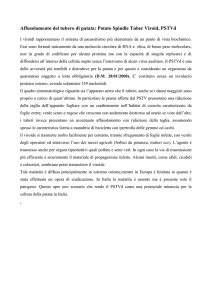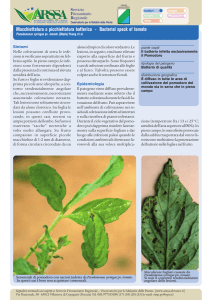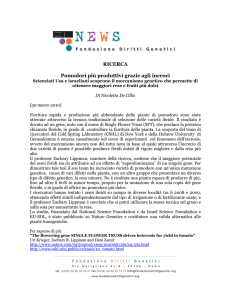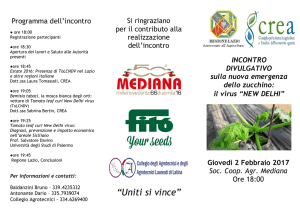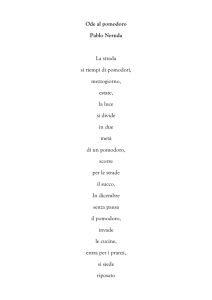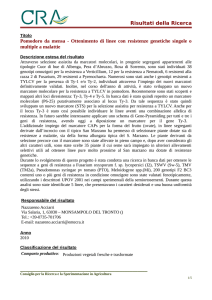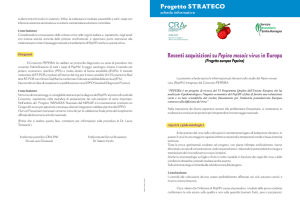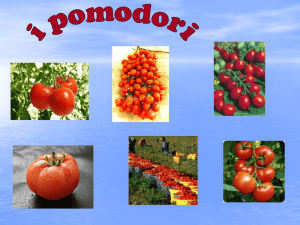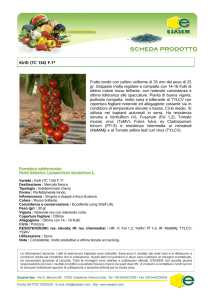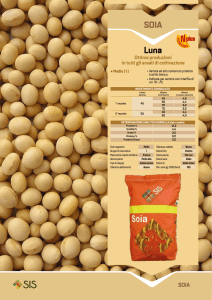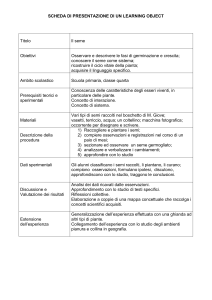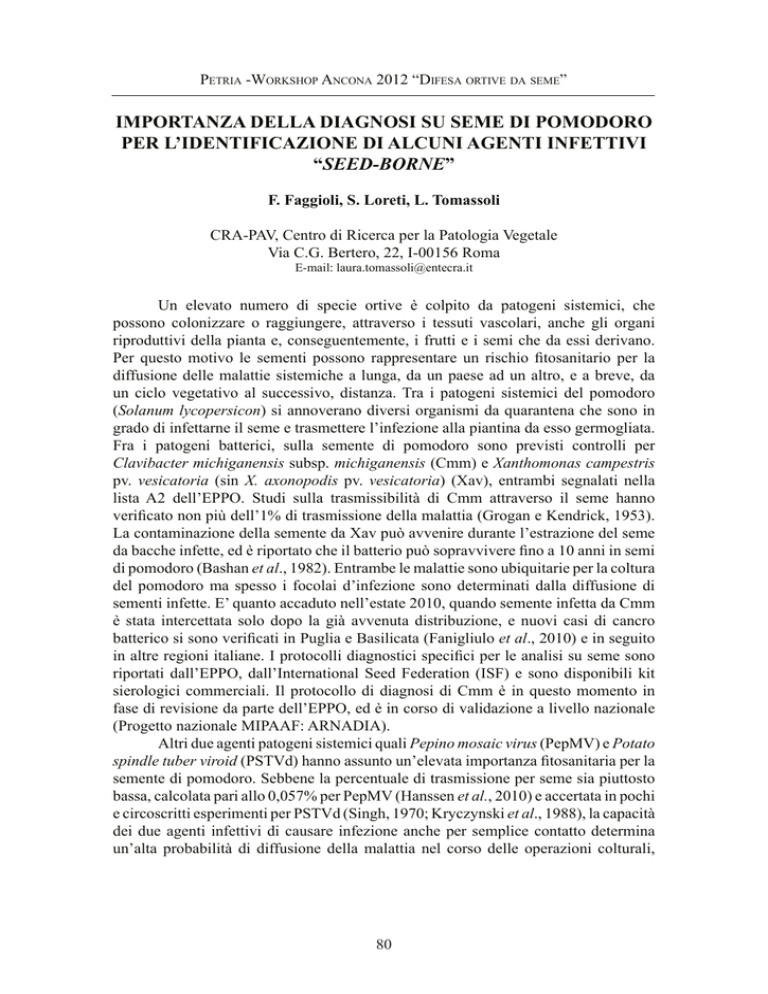
Petria -Workshop Ancona 2012 “Difesa ortive da seme”
Importanza della diagnosi su seme di pomodoro
per l’identificazione di alcuni agenti infettivi
“seed-borne”
F. Faggioli, S. Loreti, L. Tomassoli
CRA-PAV, Centro di Ricerca per la Patologia Vegetale
Via C.G. Bertero, 22, I-00156 Roma
E-mail: [email protected]
Un elevato numero di specie ortive è colpito da patogeni sistemici, che
possono colonizzare o raggiungere, attraverso i tessuti vascolari, anche gli organi
riproduttivi della pianta e, conseguentemente, i frutti e i semi che da essi derivano.
Per questo motivo le sementi possono rappresentare un rischio fitosanitario per la
diffusione delle malattie sistemiche a lunga, da un paese ad un altro, e a breve, da
un ciclo vegetativo al successivo, distanza. Tra i patogeni sistemici del pomodoro
(Solanum lycopersicon) si annoverano diversi organismi da quarantena che sono in
grado di infettarne il seme e trasmettere l’infezione alla piantina da esso germogliata.
Fra i patogeni batterici, sulla semente di pomodoro sono previsti controlli per
Clavibacter michiganensis subsp. michiganensis (Cmm) e Xanthomonas campestris
pv. vesicatoria (sin X. axonopodis pv. vesicatoria) (Xav), entrambi segnalati nella
lista A2 dell’EPPO. Studi sulla trasmissibilità di Cmm attraverso il seme hanno
verificato non più dell’1% di trasmissione della malattia (Grogan e Kendrick, 1953).
La contaminazione della semente da Xav può avvenire durante l’estrazione del seme
da bacche infette, ed è riportato che il batterio può sopravvivere fino a 10 anni in semi
di pomodoro (Bashan et al., 1982). Entrambe le malattie sono ubiquitarie per la coltura
del pomodoro ma spesso i focolai d’infezione sono determinati dalla diffusione di
sementi infette. E’ quanto accaduto nell’estate 2010, quando semente infetta da Cmm
è stata intercettata solo dopo la già avvenuta distribuzione, e nuovi casi di cancro
batterico si sono verificati in Puglia e Basilicata (Fanigliulo et al., 2010) e in seguito
in altre regioni italiane. I protocolli diagnostici specifici per le analisi su seme sono
riportati dall’EPPO, dall’International Seed Federation (ISF) e sono disponibili kit
sierologici commerciali. Il protocollo di diagnosi di Cmm è in questo momento in
fase di revisione da parte dell’EPPO, ed è in corso di validazione a livello nazionale
(Progetto nazionale MIPAAF: ARNADIA).
Altri due agenti patogeni sistemici quali Pepino mosaic virus (PepMV) e Potato
spindle tuber viroid (PSTVd) hanno assunto un’elevata importanza fitosanitaria per la
semente di pomodoro. Sebbene la percentuale di trasmissione per seme sia piuttosto
bassa, calcolata pari allo 0,057% per PepMV (Hanssen et al., 2010) e accertata in pochi
e circoscritti esperimenti per PSTVd (Singh, 1970; Kryczynski et al., 1988), la capacità
dei due agenti infettivi di causare infezione anche per semplice contatto determina
un’alta probabilità di diffusione della malattia nel corso delle operazioni colturali,
80
Petria 22 (2), 65-122 (2012) -Workshop Ancona 2012 “Difesa ortive da seme”
anche con sorgente di inoculo costituita da poche piantine. PepMV è stato identificato
in Europa nel 2000 (Van der Vlugt et al., 2000) e si è rapidamente diffuso in molti
paesi. Il sospetto iniziale che il seme fosse una via di trasmissione è stato provato da
numerose ricerche. Per tale motivo, la Decisione Europea 2004/200/EU ha imposto il
divieto di introduzione da paesi terzi e circolazione tra i paesi comunitari di semente di
pomodoro infetta dal virus, rendendo obbligatorio il passaporto fitosanitario. Diversi
protocolli diagnostici specifici per le analisi su seme di pomodoro sono forniti da
Ditte commerciali per kit sierologici, o dall’ISF ma soprattutto protocolli diagnostici
sierologici e molecolari sono stati validati sia a livello europeo (Progetto: PEPEIRA)
che nazionale (Progetto MIPAAF: ARNADIA).
Diversa è la situazione riguardo il PSTVd, organismo da quarantena presente
nell’allegato I/A1 della Direttiva 2000/29/EC. Questo viroide è stato inizialmente
studiato su patata e tutte le normative fitosanitarie originariamente si riferivano a
questa specie. Recentemente però, le infezioni accertate su ornamentali e i casi di
focolai su pomodoro, gli hanno conferito una maggiore importanza e pericolosità in
molti paesi. Specificatamente, dopo le prime segnalazioni su Solanum jasminoides
e pomodoro (Verhoeven et al., 2006, 2008; Di Serio, 2007; Navarro et al., 2009),
il mondo scientifico si è particolarmente attivato per aumentare le conoscenze
epidemiologiche, biologiche e diagnostiche per le nuove combinazioni ospite/PSTVd
(progetto EUPHRESCO e bando Floricoltura MIPAAF: PSTVd-free). In particolare,
la voce “seme pomodoro” rappresenta una delle linee di ricerca principali su cui
investigare per ottenere dati certi sul ruolo del seme nella diffusione e, quindi, definire
i parametri per un buon campionamento e una diagnosi sensibile. A questo proposito,
nel 2012 ha preso il via un EUPHRESCO di cui l’Italia fa parte con il CRA-PAV.
Non tutti i paesi da cui l’Italia importa seme di pomodoro appaiono trasparenti o
attivi in materia fitosanitaria. Risulta difficile, infatti, ottenere dati certi in letteratura
sulla presenza o meno, in questi paesi, dei patogeni illustrati. Pertanto, in attesa
di ulteriori sviluppi sia della ricerca che degli aspetti legislativi, si auspica un alto
livello di guardia nei controlli delle sementi di pomodoro al fine di ridurre il rischio di
diffusione ed endemizzazione di questi patogeni in Italia.
Parole chiave: Cmm, PepMV, Pomodoro, PSTVd, Semente, Xav.
Importance of routine diagnosis for systemic pathogens on
tomato seeds
A large number of crops are affected by systemic pathogens that can colonize
the reproductive organs as well as the fruits and seeds. For this reason, seeds can
pose risks regarding the movement and introduction of a pest from one country to
another, and from one cultivation area to another. Therefore, different vegetable
species are subject to international and national regulations that impose controls on
seeds. Specifically, tomato (Solanum lycopersicum) seed marketing (certification of
81
Petria -Workshop Ancona 2012 “Difesa ortive da seme”
pathogen-free materials) is regulated by European Directives against two bacteria:
Clavibacter michiganensis subsp. michiganensis (Cmm) and Xanthomonas campestris
pv. vesicatoria (syn. X. axonopodis pv. vesicatoria), (Xav) that are included in the
EPPO A2 list of quarantine organisms. Cmm seed transmission has been investigated,
ascertaining not more than 1% of disease transmission (Grogan and Kendrick, 1953).
Xav seed contamination generally occurs during seed extraction from infected berries,
and this bacterium can survive on tomato seeds for periods of at least 10 years (Bashan
et al., 1982). Both diseases are ubiquitous for growing tomatoes, and new outbreaks
are often caused by infected seed as the inoculum source. Since summer 2010, new
outbreaks of tomato canker (Cmm) have been recorded in Apulia and Basilicata
(Fanigliulo et al., 2010), and more recently in other Italian regions, as consequence
of the previous distribution of infected tomato seeds. Specific diagnostic protocols for
seed analysis have been reported by EPPO, the International Seed Federation (ISF),
and commercial serological kits are available. Furthermore, the Cmm diagnostic
protocol is currently under review by the EPPO, and its validation is in progress at a
national level (national MIPAAF Project: ARNADIA).
Two other systemic pathogens, Pepino mosaic virus (PepMV) and Potato
spindle tuber viroid (PSTVd) have assumed high importance for tomato seeds. Both
pathogens can also infect tomato seeds, and have the potential to infect the emergent
plantlets. The PepMV seed transmission rate has been calculated at around 0.057%
(Hanssen et al., 2010), while PSTVd seed transmission has been investigated in few
experiments (Singh, 1970; Kryczynski et al., 1988); both of these pathogens can be
transmitted by contact, so from a few infected seedlings, the disease can spread rapidly
throughout a field. PepMV was first identified in Europe in 2000 (Van der Vlugt et
al., 2000), and then suddenly spread to many countries. European Decision 2004/200/
EU imposed a ban on the introduction of tomato seeds infected by PepMV from Third
World countries, and their circulation among the EU countries. Specific diagnostic
protocols for PepMV detection on tomato seeds are available and are provided by
companies that produce serological kits, or by the ISF; in particular, serological and
molecular diagnostic protocols have been validated both at European (European
project: PEPEIRA) and national levels (MIPAAF Project: ARNADIA).
PSTVd is a quarantine pathogen that is included in list I/A1 of Directive
2000/29/EC. This viroid was initially studied in potato, and originally all of the
phytosanitary regulations referred to this species. Recently, infection on ornamental
plants and cases of outbreaks on tomato have promoted greater concern for PSTVd.
Specifically, after the first reports of PSTVd on Solanum jasminoides and tomato
in Europe and Italy (Verhoeven et al., 2006, 2008; Di Serio 2007; Navarro et al.,
2009), scientists have improved the knowledge of the epidemiological, biological and
diagnostic aspects of new host-PSTVd combinations (EUPHRESCO and MiPAAF
projects). In the light of the foregoing, the ‘tomato seed’ question represents one of
the main research lines for investigation, because unlike PepMV, there are no reliable
data on the role of seed dissemination and on the actual percentage of seed infection,
and therefore it is not possible to define the parameters for good sampling and for
82
Petria 22 (2), 65-122 (2012) -Workshop Ancona 2012 “Difesa ortive da seme”
the determination of the sensitivity of diagnostic methods for the identification of
PSTVd directly in batches of seeds. In this regard, in 2012, the European project
EUPHRESCO was started, in which Italy (through CRA-PAV) is taking part.
It should be stressed that not all of the countries from which Italy imports
tomato seeds are active in plant health, and it is difficult to obtain reliable data on the
presence or absence of those pathogens in tomato growing areas. Therefore, pending
further developments in research and legislative matters, it is suggested that a high
level of vigilance be maintained in the control of tomato seeds, to reduce the risk of
the spread of these pathogens in Italy.
Key words: Cmm, PepMV, PSTVd, Tomato seeds, Xav.
Lavori citati/References
Bashan Y., S. Diab, Y. Okon, 1982. Survival of Xanthomonas campestris pv.
vesicatoria in pepper seeds and roots, in symptomless and dry leaves in nonhost plants and in the soil. Plant and Soil, 68, 161-170.
Di Serio F., 2007. Identification and characterization of Potato spindle tuber viroid
infecting Solanum jasminoides and S. rantonnetii in Italy. Journal of Plant
Pathology, 89, 297-300.
Fanigliulo A., A. Viggiano, G. Piegari, A. Crescenzi, 2011. Serious outbreak of
Clavibacter michiganensis subsp. michiganensis on tomato in Southern Italy.
Acta Horticulturae, 914, 43-46.
Grogan R.G., J.B. Kendrick, 1953. Seed transmission, mode of overwintering and
spread of bacterial canker of tomato caused by Corynebacterium michiganense.
Phytopathology, 43, 473.
Hanssen I. M., R. Mumford, D.R. Blystad, I. Cortez, B. Hasiów-Jaroszewska,
D. Hristova, I. Pagán, A.M. Pereira, J. Peters, H. Pospieszny, M. Ravnikar,
I. Stijger, L.Tomassoli, C. Varveri, R. van der Vlugt, S. L. Nielsen, 2010.
Seed transmission of Pepino mosaic virus in tomato. European Journal of
Plant Pathology, 126, 145-152.
Kryczynski S., E. Paduch-Cichal, L.J. Skrzeczkowski, 1988. Transmission of three
viroids through seed and pollen of tomato plants. Journal of Phytopathology,
121, 51-57.
Navarro B., M.R. Silletti, V.N. Trisciuzzi, F. Di Serio, 2009. Identification and
characterization of Potato spindle tuber viroid infecting tomato in Italy. Journal
of Plant Pathology, 91, 723-726.
Singh R.P., 1970. Seed transmission of potato spindle tuber virus in tomato and potato.
American Potato Journal, 47, 225-227
Van der Vlugt R.R.A., C.C.M. Stijger, J.T.J. Verhoeven, D.E. Lesemann, 2000.
First report of Pepino mosaic virus on tomato. Plant Disease, 84, 103.
Verhoeven J.T.J., C.C.C. Jansen, J.W. Roenhorst, 2006. First report of Potato virus
M and Chrysanthemum stunt viroid in Solanum jasminoides. Plant Disease,
90, 1359.
83
Petria -Workshop Ancona 2012 “Difesa ortive da seme”
Verhoeven J.T.J., C.C.C. Jansen, J.W. Roenhorst, 2008. First report of pospiviroids
infecting ornamentals in the Netherlands: Citrus exocortis viroid in Verbena
sp., Potato spindle tuber viroid in Brugmansia suaveolens and Solanum
jasminoides, and Tomato apical stunt viroid in Cestrum sp. Plant Pathology,
57, 399.
84

